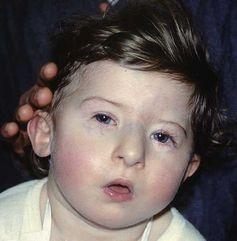The most common syndrome you have never heard of: 22q11.2 deletion
One in 2,000 people are born with “22q”, which can cause heart defects and physical and learning disabilities, but awareness of the condition throughout society is low

Your support helps us to tell the story
From reproductive rights to climate change to Big Tech, The Independent is on the ground when the story is developing. Whether it's investigating the financials of Elon Musk's pro-Trump PAC or producing our latest documentary, 'The A Word', which shines a light on the American women fighting for reproductive rights, we know how important it is to parse out the facts from the messaging.
At such a critical moment in US history, we need reporters on the ground. Your donation allows us to keep sending journalists to speak to both sides of the story.
The Independent is trusted by Americans across the entire political spectrum. And unlike many other quality news outlets, we choose not to lock Americans out of our reporting and analysis with paywalls. We believe quality journalism should be available to everyone, paid for by those who can afford it.
Your support makes all the difference.You wouldn’t be blamed for thinking that 22q11.2 was a postcode or password. My guess is you wouldn’t have thought it was the most prevalent syndrome of its kind.
The condition, commonly referred to as DiGeorge syndrome, can cause a range of lifelong problems including heart defects and learning difficulties with varying degrees of severity. The prevalence of “22q” is considered to be around one in 2,000 live births globally. This number is constantly under review, however, with the syndrome potentially more common than initially thought. Many people go through life without a diagnosis.
So let’s talk about 22q.
Everyone has 23 pairs of chromosomes – that’s 46 all together. Chromosomes are made of genes, which themselves are built of DNA. Think of a chromosome as a complete puzzle; the genes are the individual pieces and the DNA is the pattern or picture. When the different pieces are fixed together, they create a complete chromosome. In people with a genetic syndrome like 22q, a piece of the puzzle is missing, leaving the picture incomplete.
In 22q, the missing section is found on the “q arm” – the longer of each chromosome's two arms – of the 22nd chromosome, at a position identified as 11.2. These two locations combine to become 22q11.2. The missing section can differ in size, meaning people can experience different symptoms. However, there is a core region commonly deleted in all.
What problems occur in 22q?
Because of the myriad problems associated with 22q, many different specialists are involved in diagnosing and treating it. It doesn’t help that specialists refer to certain forms of 22q by various names – DiGeorge is one, velocardiofacial syndrome is another. These share a 22q deletion yet are considered different syndromes. In my world of research, however, we talk about it all as “22q”.
When a diagnosis is first made, the focus is commonly on the physical effects of the syndrome, such as a cleft palate or heart defects. These effects are of course what dictates when and why a diagnosis is sought. Some diagnoses occur because of behavioural or developmental problems – autism-like symptoms or inattention and hyperactivity, for example – not just physical. These developmental and psychiatric problems become more apparent with age but can be traced back to earlier years.

22q has one of the highest prevalences of developmental delay and congenital heart disease, second only to Down’s syndrome. Further similarities include both having a broad range of symptoms – including poor muscle tone and differences in digit length of both fingers and toes – and facial features. These tend to be more easily identified in Down’s syndrome, but can be evident in 22q.
22q also puts individuals at increased risk of schizophrenia. In the general population, 1-2 per cent of people have schizophrenia. For 22q patients, this rate is higher, at around 25-30 per cent of people. 22q is one of the highest implicated genetic changes of its kind for development of schizophrenia. Strikingly, this elevated risk is higher than having one parent with schizophrenia, which is 10 per cent. Having such a pronounced and stigmatised disorder at this risk level highlights the need for more understanding of 22q, as well as better interventions and treatments.
Other psychiatric disorders are more prevalent in 22q as well, including anxiety disorders, attention-deficit hyperactivity disorder (ADHD) and autism. Epilepsy and impaired motor coordination are also common.
One of the most uncharted problems of 22q is that of sleep disturbances, which is what I am currently researching. Some people with 22q have physical sleep-related problems such as obstructive sleep apnoea, however sleep-related behavioural and psychological problems have yet to be fully investigated.
How people with 22q sleep, both from a physiological view of brain activity to comfort and restlessness, can open the doors to understanding more about 22q as a multiplex syndrome. My work involves assessing children and adolescents’ brain activity during a night’s sleep. Coupling electroencephalography (EEG), which records electrical activity in the brain, with other objective sleep measures, can help us to create a better picture of what sleep is like in 22q.
Why is 22q important?
Families taking part in our research give a brief window into their lives, and we get snippets of the day-to-day realities of living with the syndrome. Although I would never claim to know what it’s like to have a child or be an adult with 22q, I greatly sympathise with the problems they experience.
Immediate life threatening heart defects at birth, and developmental delay and sensory processing problems can aggregate in childhood. The emergence of hallucinations and delusions in early adolescence can manifest into schizophrenia and anxiety, which can have a debilitating impact in adulthood.
Dealing with each of these problems separately takes a lot of strength and perseverance on the part of a person and their family. The cocktail of problems faced everyday make for a bitter pill to swallow and are difficult to ignore.
However, society’s lack of awareness is unhelpful. Having to explain yourself day after day, being stigmatised, judged, or confronted with a face of confusion and lack of empathy must be beyond unbearable.
Researchers like myself are working hard to make sure 22q is investigated, taught, and discussed more widely, so that people and their families who are affected are given the understanding they deserve.
Hayley Moulding is a PhD student in neuropsychiatric genetics and genomics at Cardiff University. This article was originally published on The Conversation (www.conversation.com)
Join our commenting forum
Join thought-provoking conversations, follow other Independent readers and see their replies
Comments